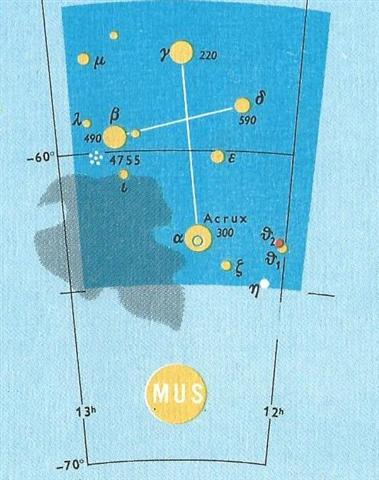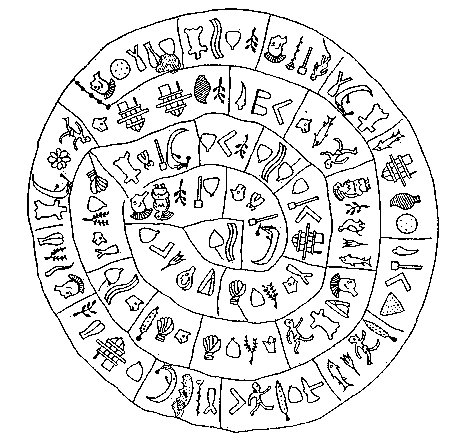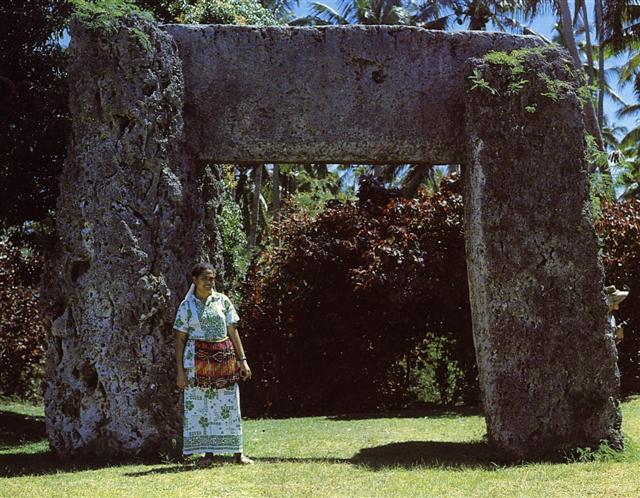7-4. After now having clarified the total number of 'letters' on the Phaistos disc, let's complete our review with a structure for the 'dictionary of glyph types' stated by TV to be 46 (→ 288 - 242):
With my definition of what a glyph type should be I cannot be convinced there are more than about 37 types on the disc. To ascertain that I have not missed any in my overview above I will enumerat how many there are of each type as distributed on the departments of the text. But in order to do so we had better first 'roll out' the pair of spiral sequences:
¹ I have regarded the variant of the 'head of the warrior' (my type number 9) without 'bird feathers' as no separate type.
² The 'root' of this variant of the '5-branched bush' (my type number 12) extends indefinitely downwards, but this should not be sufficient reason for regarding it as a separate type. Similarly I will not accept the feature exhited 4 glyphs later at the variant of my type 25 - stretching both up an down to the 'help lines' - as enough reason for establishing yet another type of glyph. Instead we should perceive these added features as just that, viz. as additions for clarifying or extending meaning. ³ Quite possibly this indistinct glyph could represent yet another type, in which case my number of types would increase to 38. This method of rolling out the departments of the spiral glyph sequence secures my counting of the number of glyphs. It also reveals the possibility of 'binomes', for instance type 2 followed by type 9:
¹ I regarded this glyph as just a variant of my type 10, but maybe I was wrong because the 'stem' is not straight. 37 + 1 + 1 = 39. ² This bird is heading in the same general direction as compared to the same type of bird in department 7, but in the opposite direction as compared to that in e.g. department 10. The general direction of reading is from left to right although I have perceived the type of bird is rather to be compared to 'Raven' than to 'Columba' (with a green twig in her beak).
And birds are sleeping with their head under their wing. Therefore my basic type 5 should be heading back:
³ I have come to regard this glyph as a variant of number 11 in spite of exhibiting special features (a division of the lower end and an extension like that in department 16). We can see that probably this is a correct interpretation because it is the same sequence as in department 10. Notably the long department 15 has a sequence of types which is the same as that in department 3. And department 15 is in the middle between department 12 and department 18 which also are 'twin sequences'.
¹ I saw this glyph as only a shorter variant of the normal 'wave-formed double-river' (16), but possibly it was intended as a separate entity. ² Perhaps a damage has obliterated a glyph at this place. Cfr the only partly visible glyphs 4-5 steps ahead. On the other hand it could have been the result of deliberate action. ³ After some hesitation I decided this glyph did not represent a type which essentially differed from the 'head of the dog' (26), in spite of its irregularity and lack of mouth and eye. Cfr how 12 glyphs later there is a pair of dog heads followed 4 glyphs later by what seems to be the head of an 'inverted and blinded dog'. But there is definitely no certainty. From this exercise I suggest the number of glyphs on side a of the disc should be regarded as 123. On the G tablet there are 123 glyphs from Ga2-27 (57) up to and including Ga7-10 (179). And 365 - 123 = 242, corresponding to the number of glyphs on side b of the G tablet. Now we will move on to side b on the disc, beginning in the center as on side a. South of the equator the direction up should be in the south.
¹ At this place we can clearly see how the canoe (27) is secured to the following pole (10), a fact which can be confirmed by looking at the pair on side a (in the identical 6-glyph departments 12 and 18). ² Similarly we can here see that number 28 is depicting a kind of insect, with head and antennae in front. Possibly the bottom part describes its wings.
¹ This glyph could be a variant of number 11. On the other hand, if it is intended to be an example of my glyph type 11, then it is depicted upside down. In department 19 on side b I hesitated whether we should count the vertical string not joined to the helpline above or not. But finally I decided not to count it, and we should instead regard it as an additional feature to clarify or extend the meaning. Which means the number of glyphs on side b becomes 118 (→ 4 synodic lunar months):
¹ At first it appears rather obvious there has been an accidental damage here of some original glyph. However, there is no sign of any similar damage close by, not even partially having destroyed any other glyph. My suggestion is therefore that the 'damage' was intentional, possibly to indicate a day zero. Department 22 could suggest π. ... About Carmenta we know from the historian Dionysus Periergetis that she gave orcales to Hercules and lived to the age of 110 years. 110 was a canonical number, the ideal age which every Egyptian wished to reach and the age at which, for example, the patriarch Joseph died. The 110 years were made up of twenty-two Etruscan lustra of five years each; and 110 years composed the 'cycle' taken over from the Etruscans by the Romans. At the end of each cycle they corrected irregularities in the solar calendar by intercalation and held Secular Games. The secret sense of 22 - sacred numbers were never chosen haphazardly - is that it is the measure of the circumference of the circle when the diameter is 7. This proportion, now known as pi, is no longer a religious secret; and is used today only as a rule-of-thumb formula, the real mathematical value of pi being a decimal figure which nobody has yet been able work out because it goes on without ever ending, as 22 / 7 does, in a neat recurring sequence [3.142857142857 ...]. Seven lustra add up to thirty-five years, and thirty-five at Rome was the age at which a man was held to reach his prime and might be elected Consul. (The same age was fixed upon by a Classically-minded Convention as the earliest at which an American might be elected President of the United States.) ...
² Possibly I should add a glyph type to my listed 37 above, corresponding to this glyph and the same type of inverted 11 as noted earlier at department 17. But I have decided not to do so, in which case we could say the number of intended glyph types could be around 37 + 1 +1 = 39 (and definitely not as many as 46). There are remarkable similarities between the text on the Phaistos disc and the texts on the rongorongo tablets. Number of glyphs did count, but number of glyph types were basically unlimited, especially if perceiving added features as reason for new types.
On the Keiti (E) tablet we can find a phenomenon quite similar to 'day zero' on the Phaistos disc, located after Ea8-4 (→ 84), viz. where we could have expected to find glyph number 256 + 5 = 261. We can count 9 * 29 = 261. Similarly, on the Phaistos disc; 9 * 23 = 207 = 123 + 85.
|
||||||||||||||||||||||||||||||||||||||||||||||||||||||||||||||||||||||||||||||||||||||||||||||||||||||||||||||||||||||||||||||||||||||||||||||||||||||||||||||||||||||||||||||||||||||||||||||||||||||||||||||||||||||||||||||||||||||||||||||||||||||||||||||||||||||||||||||||||||||||||||||||||||||||||||||||||||||||||||||||||||||||||||||||||||||||||||||||||||||||||||||||||||||||||||||||||||||||||||||||||||||||||||||||||||||||||||||||||||||||||||||||||||||||||||||||||||||||||||||||||||||||||||||||||||||||||||||||||||||||||||||||||||||||||||||||||||||||||||||||||||||||||||||||||||||||||||||||||||||||||||||||||||||||||||||||||||||||||||||||||||||||||||||||||||||||||||||||||||||||||||||||||||||||||







